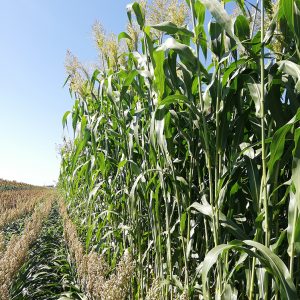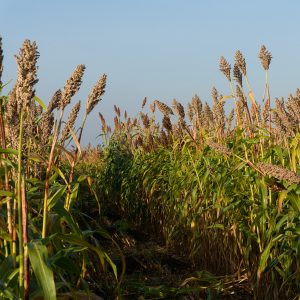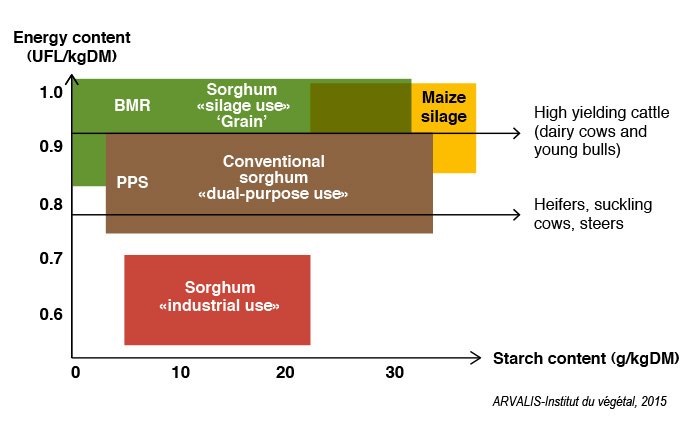Using sorghum silage as feed for dairy and suckler herd

Silage sorghums BMR without grains – Dual-purpose use sorghums – Grain Sorghum – Silage sweet sorghums BMR with grains
The existing broad genetic diversity of sorghum is a real opportunity for the nutrition of ruminants. However, this diversity can also be seen as difficult in managing the feeding of a cattle herd. The aim of this article is to make you more familiar with the different types of sorghum and to facilitate their use.
The first step is to distinguish the different types of fodder sorghum and their characteristics, which can be classified in 2 broad families: multi-cut sorghums (Sudan grass or hybrids Sudan grass*sorghum bicolor) and single-cut sorghums (sorghum bicolor), issued from different genetic types: classic sweet sorghum with or without grains (male-sterile, PPS ), sweet sorghum with the BMR gene with or without grains (male-sterile, PPS), sorghum targeted towards grain production but ensiled as a whole plant.
« Silage » sweet sorghums BMR without grains (male-sterile, PPS)
 Same energy value (feed units, FU) as maize.
Same energy value (feed units, FU) as maize.
Different energy profile compared to maize: low starch level, very digestible fibres.
Objective: minimum 25% dry matter (DM) at harvesting.
Features:
• Improves the digestibility of feed rations
• Maintains 4% fat milk (gross decrease of milk but increase of fat level)
• Positive effect on feed efficiency
• Slight decrease of DM ingestion rate
• Profitability (low input consumption) even if the DM yield of sorghum is 10% lower than maize
« Silage » sweet sorghums BMR with grains
 Same energy value (FU) as maize.
Same energy value (FU) as maize.
The energy profile is quite different compared to maize: moderate starch level (5-25% of the DM), very digestible fibres.
Objective: minimum 25% dry matter (DM) at harvesting, with a major issue at the end of the cycle, with a significant risk of lodging with these sorghums.
Features:
• Improves the digestibility of feed rations
• Maintains 4% fat milk (gross decrease of milk but increase of fat level)
• Positive effect on feed efficiency
• Slight decrease of DM ingestion rate
• Profitability (low input consumption) even if the DM yield of sorghum is 10% lower than maize
PPS: day-length sensitive. These sorghums do not ear in our climate.
Sorghum grain ensiled as a whole plant
 Energy value = 95% of that of maize.
Energy value = 95% of that of maize.
Objective: 30% dry matter (DM) at harvesting.
Features:
• Average starch contents 25 to 35% of DM
• Improves DM ingestion by 25 to 35%
• Maintains the daily weight gain and milk production if incorporated in a balanced ration
• Economically profitable if the DM yield of sorghum is 10% higher than maize
« Dual-purpose use » sweet sorghums
Energy value = 80 to 90% of that of maize.
Objective: minimum 25% dry matter (DM) at harvesting.
Features:
-
- • Higher DM yield than « silage » sorghums (but not in dairy fodder unit (UFL)/ha)
-
- • 5 to 10% decrease of DM ingestion, daily gains and milk production
-
- • Profitability if the production costs of sorghum are 80% of that of maize
- • Incorporation recommendation into the ration of 2 to 4 kgDM / day / cow, or basic ration for heifers or suckler cows
-
- • Dual-purpose use sorghum can be used for industrial purposes
Multi-cut sorghums (Sudan grass or hybrid Sudan grass*sorghum bicolor)
High DM/ha yield
Energy value = 70% of that of maize.
Objective: minimum 25% dry matter (DM) at harvesting.
Features:
-
- • Several cuts possible each year
-
- • Quick growth
- • Hardiness, resistant to hydric stress
-
- • Very low production cost
The energy value is very variable depending on the type of sorghum, between 0.6 and 1 UFL/kg of DM. This energy mostly comes from fibres rather than starch (mostly for BMR sorghums). Therefore, highly digestible and low in starch sorghum (BMR sorghums) is perfectly adapted to completed a feed ration based on silage maize. Grain sorghums (highly digestible and rich in starch) have the same features as silage maize.
The graph here under gives the different energy content and starch contents of sorghum types:

Silage use of BMR sorghum without grains is complementary to starch-rich maize silage, as it enables to lower the starch contents of the ration and to improve its digestibility and feed efficiency. Moreover, for dairy cattle the quality of milk is improved as the fat content increases by 5 to 10%. Despite the lower production of raw milk / cow, the higher fat content maintains milk production stable at 4% fat.
In conclusion, the different sorghum types present a significant diversity of features linked to their chemical composition and their feed value. They are adapted to many possible uses to form a balanced ration, but it is important to be informed and to study their features in order to use them correctly and to be fully satisfied.
Continue ?
Discover our field trials

Sorghum, water and profitability. Farmers testify.













